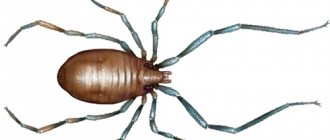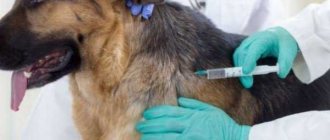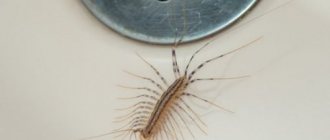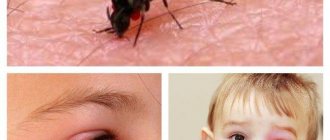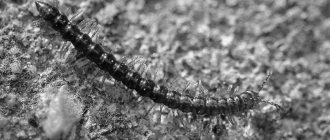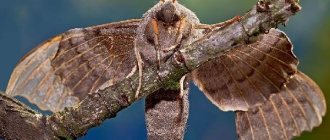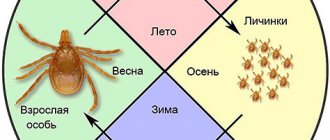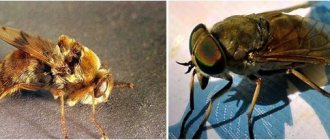: 27 Feb 2022, Echo of Memory, volume 85, No. 5/6
Every year, hundreds of thousands of people visit medical institutions due to a tick bite. For these blood-sucking parasites, humans are only incidental “prey,” but ticks serve as carriers of a whole arsenal of pathogens that cause diseases in humans and animals. Anyone who spends time in nature, including our pets, can face the problem of tick-borne infections; Farm animals also suffer from tick-borne infections. The purpose of this article is to better acquaint readers with the habits and lifestyle of ixodid ticks, primarily common in our country, which can carry about three dozen diseases, including tick-borne encephalitis and borreliosis. In recent years, the problem of tick-borne infections has been aggravated by the fact that the range of these ticks both in Russia and in other countries of the world is rapidly expanding
Ixodid ticks are found in all parts of the world, including islands and coasts of the Arctic and Antarctic, and in various climatic zones - from taiga to desert (Balashov, 1998). Among them there are both fairly “omnivorous” and highly specialized species that feed only on birds, chiropterans or small mammals (Estrada-Pena et al
., 2017).
The main harm from ticks to host animals is associated with the direct parasitism of a large number of ticks on individuals, which can lead to high blood loss or severe intoxication as a result of parasite saliva entering the body. There are known cases of death of wild animals due to massive parasitism of ixodid ticks: wild antelope in the Zimbabwe National Park, young white-tailed deer in the USA, moose in Canada and the northern USA.
The incidence of ticks in farm animals can also be very high in the absence of special anti-tick treatment. Thus, one individual of cattle can simultaneously feed on several dozen, and during the season – several hundred ticks; the total blood loss is calculated in liters! Even cases of death of sheep as a result of several hundred ticks parasitizing them have been described (Balashov, 1998).
As for humans and their pets, such as dogs, the main danger of ticks for them is the high risk of infection in the event of even a single bite. Ixodid ticks carry pathogens of viral, bacterial and protozoal infections that can infect people. It is impossible to eradicate such diseases, since their foci exist in nature regardless of humans, and the vectors themselves are an integral part of natural ecosystems. And to protect yourself from ticks, you need to know the behavior and ecology of our potential “enemy”.
General description and habitats of ticks
The size of ticks, depending on the variety, can vary from 0.1 to 20 mm. They are distinguished by a solid body, covered on the outside with a cuticle, without pronounced segmentation.
The oral organs of ticks are presented in the form of a cutting, piercing-sucking or gnawing proboscis. Parasites breathe through the entire surface of the body or through the trachea. The digestive system is well developed, but the circulatory system is not sufficiently expressed. One of the characteristic features of ticks is colorless blood. The nervous system is represented by a ganglion and nerve trunks. The excretory system consists of tubes.
When describing ticks, it is worth noting that all species are dioecious. The females of these parasites are mainly oviparous. There are several phases of tick development: egg, larva, which has three pairs of limbs, nymph and adult.
Many ticks (ixodid, argasid, gamasoid) lead an ectoparasitic lifestyle. Moreover, only some belong to endoparasites (pathogens of demodicosis in dogs and cattle).
Some ticks can be stationary parasites for animals (for example, scabies pathogens), while others are only temporary parasites (for example, ixodid ticks).
Ticks most often live in moist, shady places. They can be found not only in forests, parks or gardens, but also in shrubby areas of open spaces, meadows and fields. Ticks are most active in March-May and August-October. In summer, their activity, on the contrary, decreases, and in winter they hibernate. As the ambient temperature rises and air humidity increases, ticks “wake up” in their habitats, and they have an urgent need for food. It is during this period that these parasites actively attack animals and humans.
Duration of parasite activity
Mites of the genus Dermacentor are very cold-resistant. They wake up when the first thawed patches appear. The peak of their activity occurs in April-May: hungry and aggressive adults attack large and medium-sized mammals. By the beginning of summer, the activity of parasites subsides; their summer diapause lasts until August.
In autumn, a second, less strong peak of tick activity is observed. Their life activity ends completely when snow falls.
In autumn, the second active phase of meadow ticks begins, although it is less pronounced than in spring.
The meadow tick is able to survive winter only at the adult stage. Hungry adults go into diapause, and females can be both hungry and well-fed, and males can only be hungry. Nymphs and larvae that do not have time to molt die, regardless of whether they are hungry or full.
Females that have engorged after midsummer enter reproductive diapause. She does not allow them to lay eggs until spring. This process prevents the death of eggs and hatched larvae during the winter cold.
The mechanism of reproductive diapause in female meadow ticks is regulated by the length of daylight hours. This phenomenon is called photoperiodic reaction. The arachnid reacts to the ratio of the length of night and day, and when daylight hours become shorter than a certain period (this value depends on the region), the diapause mechanism is triggered in its body.
Ixodid ticks: external and internal structure, development phases
Ixodid ticks are carriers of pathogens that cause piroplasmosis in domestic animals. These ticks can live in forest, steppe, foothill and other zones.
Ixodids are relatively large ticks, the size of which varies from 2 mm to 20 mm, which depends on the condition of the female (hungry females are much smaller than satiated ones). The body appearance of these mites does not have a clear division into the cephalothorax and abdomen. On the outside it is covered with a heterogeneous chitinous layer. On the dorsal and ventral sides of the body there is a large layer of chitin that forms scutes.
The size of the dorsal scute can be used to distinguish a male from a female: in males it occupies the entire upper surface, while in females the scute covers only the anterior part of the body. In the front part of the body are the oral organs, consisting of the proboscis and its base.
The structure of the proboscis of these mites includes the upper and lower jaws, as well as a pair of tentacles. The upper jaws are necessary for cutting the animal's skin before sucking blood. The lower jaw, with teeth pointing backwards, performs the function of fixation. The tentacles are the organ of touch.
As you can see in the photo, depending on the variety, ticks have a long or short proboscis on a quadrangular or hexagonal base:
On the ventral side, at the level of the second pair of legs, there is a genital opening, and behind the fourth pair of limbs there is an anus.
Males have ventral scutes near the anus. On the dorsal side, at the level of the second pair of limbs, some mites have eyes, and at the back of the body there are depressions (festoons). The spiracles (stigmas) are located on the side of the body, behind the fourth pair of legs. There is a plate around them.
One of the structural features of ixodid ticks is the presence in the intestines of a large number of blind outgrowths, which during the period of insect parasitism on animals are filled with blood.
Fertilization of mites occurs on the body of animals. After sucking blood, the females fall away and hide in shelters. After some time, they begin to lay eggs. The total number of eggs laid by one female can vary from 4 to 15 thousand. After this, the females die. Mite eggs are quite large (about 0.5 mm long). They are distinguished by their oval shape and yellow-brown color. The eggs are covered with a hard shell on top.
The internal structure of the ixodid tick is presented in this diagram:
Eggs mature over several weeks (up to a month or more). The appearance of the larva occurs through a crack in the egg shell. The size of the hatched larvae is about 1 mm. She has three pairs of legs. In this case, the larva lacks spiracles, genital opening and peritremes.
To transform into the next stage (nymph), the larva is saturated with the blood of animals. The nymph has four pairs of limbs, but lacks a genital opening.
After being saturated with the blood of animals, the nymph detaches from the host and falls to the ground or turns into an imago directly on the animal’s body. During the complete development of the parasite from the egg to the mature stage, ixodid ticks are saturated with the animal’s blood three times and molt twice. The duration of blood sucking in larvae is on average 5 days, in nymphs it varies from 3 to 10 days, in adults - 10 days. A large number of ticks remain for the winter in the external environment (and at different stages of development).
Depending on the type of development, ixodid ticks can be divided into single-host, two-host and three-host ticks.
All three active stages of development of single-host ticks take place on one animal; only the imago lays eggs in the external environment.
Two-host ticks in the larval and nymphal stages live on one host, and in the adult stage they move to another host.
In the life activity of three-host ticks, a sequential change of three hosts is observed. Moreover, the transition of the parasite from one stage to another always occurs in the external environment. It is this type of development that is most characteristic of ixodid ticks.
Larvae and nymphs of two-host and three-host ticks mainly infect mouse-like rodents; adult ticks and larvae of single-host ticks are more often found on domestic animals.
Trailer ixodids are distinguished by a long proboscis with a quadrangular base. They have no eyes. The anal groove is located anteriorly. In males, the entire ventral surface is covered with scutes. The dorsal shield, limbs and proboscis have a characteristic dark brown tint, and the cuticle of females is grayish-yellow.
The dog tick is one of the most common Ixodid ticks. It is mainly found in the northwestern and central regions of the country, and is absent in the steppe and semi-desert zones. Only one generation of this genus of ticks develops during the year.
Parasites can go hungry for more than two years. In the adult stage, they attack animals in spring and autumn. Dog ticks pose a particular danger to humans, as they transmit diseases such as Lyme disease, encephalitis and tularemia.
Look at the photos of ticks of this variety, the description of which is presented above:
Ticks from the genus Hyalomma (glasseye) are the largest (up to 2.5 cm). They are distinguished by a dark body color, a long proboscis with a quadrangular base and clearly visible eyes. The anal groove is located posteriorly. The males of these ticks are easy to distinguish by their external body structure - they have three pairs of central scutes. These parasites are mainly distributed in steppe, semi-desert and desert zones. Most ticks attack animals in the summer. Representatives of this genus are carriers of causative agents of piroplasmosis, cattle anaplasmosis and many other diseases.
Skin mites are distinguished by a characteristic spotted pattern with a silvery tint on the dorsal shield of males and females. They have a short proboscis with a quadrangular base and eyes. The anal groove is located behind the anus.
Leather mites are widespread in different regions of the country. The main feature of these ticks is the development of parasites according to the three-host type: larvae parasitize mainly mouse-like rodents, nymphs live on larger wild animals, as well as birds, and adults are found on domestic and some large wild animals. Mature ticks mainly parasitize animals in spring and autumn.
These photos illustrate the description of skin-cutting mites:
Bloodsucking mites are relatively small mites that have a short proboscis with a quadrangular base. The anal groove is located behind the anus. Bloodsucking mites lack eyes and ventral scutes in males. These parasites are more common in the steppe and forest-steppe zones, as well as in the foothills. The development of one generation in phases continues for more than a year. Most often, such ticks are carriers of piroplasmosis.
Fan-headed mites are described as relatively small, distinguished by their red-brown color. These parasites are very thermophilic. They have a short proboscis with a hexagonal base, eyes, two pairs of central scutes in males, and a groove located behind the anus. These ticks are most common in the southern, foothill and steppe regions. They parasitize animals in the spring and summer. The development of one generation of fan-headed mites occurs throughout the year.
Most often, two-host and three-host ticks are found, which are carriers of piroplasmid, anaplasmosis and other diseases.
Here you can see photos of ticks, the types of which are described above:
Expanding the boundaries
Over the past decades, the range of ixodid ticks has changed and expanded. Thus, if previously it was believed that in Russia the problem of tick-borne infections was relevant only for Siberia and the Far East, now it is well known to residents of the western regions of the country. Ticks are increasingly spreading in other regions of the planet: in the USA and Canada, China and the countries of Southeast Asia, South America.
According to scientists, one of the reasons for this phenomenon is climate warming. It has been repeatedly shown that migratory birds can carry ticks over long distances (Sparagano et al
., 2015). But if earlier ticks could not take root in the northern territories, now the situation has changed. In many regions of the planet, winters have become shorter and milder, and ticks are able to survive the winter more easily.
About 60 species of ticks from the family Ixodidae have been found on the territory of Russia, but the most dangerous are ticks of the genus Ixodes
, the main carriers of the tick-borne encephalitis virus, the causative agents of ixodid tick-borne borreliosis (Lyme disease) and borrelia from the group of relapsing fevers.
Ticks of the genera Dermacentor
,
Haemaphysalis
and
Rhipicephalus
are the main carriers of pathogenic species of rickettsia, and
Hyalomma
- the Congo-Crimean hemorrhagic fever virus (Filippova, 1977, 1997)
Thus, in Sweden and Norway for the period 1994–2008. The limit of occurrence of ticks has moved more than 200 km north along the Baltic coast (Jaenson et al
., 2012). On the North American continent, ticks began to be found almost 1000 km further north compared to the period 1943–1983. And in the mountains in the north of the Czech Republic, where temperatures have risen by 1.4° over four decades, ticks appeared at altitudes of up to 1,300 m above sea level. In Russia in the 1960s. The taiga tick was found only in the southern regions of the Komi Republic, but now it is also found in the central ones: over the past forty years, the northern border of its range has moved 150–200 km (Loktev, 2015).
The second possible reason for changes in the range of ticks is a change in the environmental situation caused by human activity. For example, naturalists who traveled to the USA in the mid-18th century noted a large number of ticks there. But a century later, due to the development of agriculture, the number of white-tailed deer, the main feeder of black-legged ticks,
, which led to a decrease in the number of these parasites. However, in the second half of the last century, the number of both host animals and ticks themselves increased manifold. Accordingly, the number of tick attacks on humans has increased as city dwellers began to spend more and more time in nature.
Recently, in Western Siberia, the range of the Pavlovsky mite
, and the cause of this event remains unclear.
At the end of the last century, its habitat was only in the territory of Altai and other mountainous regions (Salair Ridge, Kuznetsk Alatau). Now it is found in most of the studied lowland areas of the Novosibirsk and Tomsk regions, while in some areas, mainly with high anthropogenic load, the Pavlovsky tick has almost completely replaced the taiga tick
(Livanova et al., 2011; Romanenko, 2011).
Perhaps this change in range is associated with long-term anti-tick treatments of the area around large cities, which were carried out in the 1960–1980s. When these places began to be repopulated by ticks, I. pavlovskyi
received an advantage, since its life cycle is shorter, and it can feed on birds, the number of which in anthropogenic foci is higher compared to the number of large mammals, the main feeders of the taiga tick.
In some cases, the habitat of ticks is expanding southward. Thus, in Western Siberia in the 1960–1970s. range of the meadow tick
moved south, from the forest to the forest-steppe zone. The reason could be a combination of several factors: acaricidal treatment of forests and a change in the structure of rodent populations - the main hosts of the tick (Yakimenko, 2013).
INTERSPECIFIC ALLIANCES
Pavlovsky's mite
Ixodes pavlovskyi
was first discovered in the Russian Far East in the middle of the last century.
The range consists of two separated parts - eastern and western, located in the Far East and Western Siberia. In morphology, genetic characteristics and activity it is similar to the taiga tick. It serves as a carrier of the same infectious agents as the taiga tick, although their occurrence in these two types of ticks differs significantly (Rar et al
., 2017).
The movement of the Pavlovsky tick population to the north coincided with another phenomenon - the discovery of its hybrids with the taiga tick. Interspecific hybridization is a fairly common phenomenon among closely related species of ixodid ticks. However, in the vast majority of cases, these interspecific hybrids are not capable of reproduction. Thus, in Russia and Estonia, in places where the ranges of taiga and European forest ticks overlap, ticks with morphological and genetic characteristics of hybrids were found (Bugmyrin et al
., 2015).
However, the offspring obtained by laboratory crossing of these two species turned out to be infertile. The entire range of the Pavlovsky tick is located within the distribution area of the taiga tick, and molecular genetic analysis revealed ticks with a hybrid genotype in all habitats of the Pavlovsky tick in the Tomsk and Novosibirsk regions and the Altai Republic. In some places, the relative number of hybrids exceeded 30%, and among them there were hybrids of both the first and second generations (Kovalev et al
., 2015; Rar
et al
., 2019). All this suggests that these two types of ticks are capable of not only interbreeding, but also producing fertile offspring
Based on modeling of changes in climate and biotopes as a result of human activity, it was shown that in the 21st century. One can expect a reduction in the range of the taiga tick on the territory of states bordering Russia from the west, and by the end of the century this process will also take place in the European part of Russia (Yasyukevich, 2019). Presumably, in the Moscow region and the regions bordering it in the west and north-west, the taiga tick will disappear. A similar process will take place in areas to the south, where, due to climate warming, the forest will retreat, giving way to drier habitats.
At the same time, there are prerequisites for a significant expansion of the range of the taiga tick in the Kamchatka Territory and its appearance in the Magadan Region, and these forecasts are already beginning to come true. Thus, taiga ticks were recently discovered in the vicinity of Magadan (Dokuchaev, 2015). These ticks have been found on the Kamchatka Peninsula for quite a long time. At the same time, no larvae or nymphs were found there, which would be indirect evidence that in this territory the taiga tick can go through a full life cycle (according to the Center for Hygiene and Epidemiology in the Kamchatka Territory
"for 2019). Probably, the ticks are brought there by migratory birds.
What argas mites look like: appearance (with photo)
Argasid mites (argasids) are external parasites, as well as carriers of some pathogens of infectious and protozoal diseases. They are most often found in the southern regions. Some species of argasids can live in poultry houses and livestock buildings, where they briefly parasitize animals, feeding on their blood at night.
When describing this variety of ticks, it is worth noting that, unlike ixodids, argasid parasites lack dorsal and ventral scutes. The proboscis of imagoes and nymphs is on the ventral surface, so it is not visible from above. The general characteristics of argasid mites are their particularly large size and the presence of a flattened soft body. The proboscis of these parasites is similar in appearance to the proboscis of ixodid ticks.
Nymphs, like adults, have four pairs of limbs, but they lack a genital opening. The round larva has three pairs of limbs. Her proboscis is located in the front of her body.
The body structure of the Persian tick is similar in appearance to a bug. It has a flat, grayish-yellow, ovoid body with a visible edging around it. The length of the tick is 10 mm and the width is 6 mm. The insect has two pairs of legs pointing forward and two pairs pointing back. Ticks go through all stages of development: eggs, larvae, three nymphs and adults. The female parasite is capable of laying from 30 to 100 eggs, from which larvae appear after 2-3 weeks, parasitizing mainly poultry. Each tick in the nymph stage before molting feeds once on the blood of an animal for 1-2 hours, and in the adult stage - several times. It takes 3 to 8 months for the development of one generation of the Persian tick. All stages of the parasite can overwinter. The Persian tick is mainly a carrier of the causative agent of spirochetosis.
The cat tick is distinguished by a thickened body of a grayish color, which is narrowed at the anterior end. Body length can reach 15 mm. The parasite has claws on its feet. The sheep tick parasitizes sheep and other domestic animals.
This parasite goes through all stages of development: eggs, larvae, three nymphs and adults. Female ticks lay eggs in cracks in the walls of barnyards. The entire process can take from 7 to 30 days. During this time, one female is capable of laying from 50 to 500 eggs. After about 30-45 days, larvae emerge from the eggs, which attack animals in the fall. Larvae and nymphs of the cat tick can parasitize animals for up to 45 days. Having had their fill of blood, the nymphs go into hiding, where they turn into adults. Adult ticks repeatedly suck the animal's blood for 10-40 minutes. The main characteristic of cat ticks is winter blood sucking.
In summer, females lay eggs in crevices and cracks in rooms where animals are kept.
Infection with the sheep tick can lead to paralysis (sometimes death) of sheep. In addition, these ticks can be carriers of some sheep hemosporidia. Ticks are carriers and carriers of the pathogens of equine infectious encephalomyelitis, brucellosis and tularemia.
Look what argas mites look like in these photos:
Features of lying in wait and attacking the victim
Finding a host is a very important stage in the life of ticks. They use their prey for maximum saturation, increasing their mass by drinking blood a hundred times.
Blood-sucking arachnids passively lie in wait for their victims. To do this, the parasite needs to find a place that meets the following parameters:
- Optimal temperature;
- Sufficient humidity;
- Availability of production.
The meadow tick prefers wet grass fields and bushes. The parasite is located on the grass at a height of several centimeters to a meter. Most often it climbs onto dried cereal straws.
The tick rests on a blade of grass with its forelimbs extended forward. When he senses the approach of a person or animal, he begins to make oscillatory movements with his paws in order to better perceive the smell. In this case, the parasite turns towards the prey, waiting for physical contact, in order to crawl onto it.
The meadow tick is ready to attack.
On a note
The tick needs contact with the victim; it cannot jump or fall on it.
If the victim does not approach, but its presence continues to be felt nearby (up to 10 meters), the parasite can descend from its post and crawl to it. The speed of movement of the meadow tick on a horizontal surface is about 40 cm per minute.
It is also useful to read: Ear mites in humans and animals
Once on the host, the parasite moves around its body for some time in search of a place to attach. The tick prefers to attach itself where it will be more difficult for the victim to get the bloodsucker, and where it is easier for the tick itself to cut through the skin and get to the blood vessels.
In most cases, the hosts of the meadow tick are ungulates. It is most often attached to their head or neck. Other favorite attachment sites for the parasite include the groin area, armpits, ears and the area behind them. A peculiarity of this type of tick is that the parasite, before starting to suck blood, makes several test punctures of the skin.
The arachnid cuts the skin with chelicerae, plunging them deeper into the wound. At the same time, the hypostome is inserted into the hole, and the palps are bent to the sides.
The oral apparatus of a tick under a microscope.
From the very beginning of the immersion of the oral apparatus into the skin of the victim, the parasite begins to actively secrete saliva. It has an analgesic effect and suppresses the host’s immune response, so the bite goes unnoticed. In addition, after some time the saliva hardens, forming a strong cement sheath around the hypostome.
Ticks of the genus Dermacentor are characterized by a short proboscis, most of which remains above the host's skin, while the parasite is firmly attached to the site of the bite with a case of congealed saliva. Its base is much wider than the wound incision due to deposits in the victim’s skin tissue.
An adult male tick needs only an hour to satiate, but a female can feed for 9-15 days. The mass of the parasite increases by 50-100 times. The feeding process occurs unevenly. During the first 6-36 hours after the start of feeding, the mass of the tick does not change - the arachnid simply replenishes water losses. On the 2-7th day of feeding, its mass increases 10-20 times. Its greatest growth occurs in the third stage - a day before falling away.
When the female has fallen away, she needs to find a secluded and moist place to form a clutch of eggs, the number of which ranges from 3 to 6 thousand. After this she dies.
Acariform mites
True acariform mites are distinguished by their small body size (from 0.1 to 2 mm). Their mouthparts are of a gnawing or piercing type. There is no circulatory system. These mites go through all stages of development: eggs, larvae, three nymphs and adults. Many acariform mites are the causative agents of scabies in domestic animals. Some of them are involved in the development of ruminant anoplocephalids as intermediate hosts.
Depending on the belonging of scabies pathogens to different genera, it is recommended to establish a diagnosis not for scabies as a whole, but for acarosis, psoroptosis, chorioptosis and notoedrosis.
These photos show what cariform mites look like:
What to do if a nymph is bitten by a tick
If you are bitten by a tick, there is no need to panic; it often poses no danger. But it needs to be removed from the body as soon as possible, because this reduces the likelihood that a person will get sick after being bitten. When a person notices a lump on the body and realizes that it is a tick, one should act immediately.
Squeezing out the parasite with your hands will lead to nothing, as this will only make the wound more serious.
In order to remove the tick, you should use sunflower oil.
- Pour it onto the bite site and wait a little. This will close the arthropod's breathing holes and will be easy to remove.
- After removal, you need to submit the tick to a hospital laboratory to find out if it was contagious.
- Even if the bitten person feels well, it is necessary to conduct an analysis in the laboratory, because the disease may not manifest itself in any way for decades.
However, sometimes after a tick bite a person sees that he is already beginning to have health problems. If the person bitten:
- dizzy and headache;
- redness appeared at the site of the bite;
- red spots have formed;
- loss of strength and insomnia appeared.
Then you need to immediately go to the hospital. Some types of mites provoke allergic reactions and swelling. In difficult cases, people who choose to rely on chance can suffer serious harm
Destruction of ticks in nature
Ixodid ticks lay eggs on the ground, and some ticks choose wet places for laying, others dry ones, and others choose forest ones. If these conditions are violated, the tick eggs and the ticks themselves often die. To disrupt the living conditions of ticks in natural conditions and in order to destroy ticks at different stages of development, they carry out isolation and change of grazing areas, agricultural activities (plowing virgin lands, reclamation of wet pastures, weeds and weeds in autumn and spring, extermination of mouse-like rodents), and use chemicals methods, as well as natural enemies of ticks.
Isolation and change of grazing
are used in the fight against ticks Boophilus calcaratus, as well as Rhipicephalus bursa, which feed only on domestic animals. The main requirement when changing pastures is to prevent domestic animals from entering the tick-infested area of the pasture for a period during which the ticks die of starvation (Boophilus calcaratus after 6-7 months, Rhipicephalus bursa after ten months). If you graze livestock on each plot for 25 days (the development of the Boophilus calcaratus tick from a larva to a suckling female takes 21-24 days) and return to the previously used plot after seven months, you can free the pasture area from ticks of this species in one year.
The alternation of lowland (winter) and mountain (summer) pastures in the south of the country plays an important role in the fight against ticks Boophilus calcaratus and Rhipicephalus bursa. It is necessary to move cattle in the spring to subalpine pastures before ticks become active (cattle in early April, and sheep no later than mid-May). Against most ixodid ticks, changing pastures is ineffective, since these ticks are capable of fasting for a longer period of time (more than one year) and can feed not only on domestic animals, but also on wild animals.
Agricultural activities
carried out in tick habitats.
This creates unfavorable conditions for the life of ticks in pastures and other places, as a result of which the number of ticks and other parasitic arachnids in nature decreases. Depending on natural conditions and the species composition of ticks, certain measures predominate in the complex of agricultural measures. Reclamation (drainage)
of swampy and low-lying pastures leads to changes in the habitats of moisture-loving ticks in an unfavorable direction for them, resulting in their mass death.
In autumn and spring, burning
tall, dry grass, weeds and weeds, which serve as a refuge for ticks and their hosts - small wild animals, in certain areas of pastures in autumn and spring, helps to sharply reduce the incidence of ticks in these places.
Deep plowing, disking and harrowing of
pastures, destruction of hummocks and bushes, sowing of annual and perennial grasses on natural pastures are important links in the fight against ticks.
Chemical methods
Tick control in natural conditions is sometimes carried out by spraying acaricide dusts using helicopters and airplanes and, in limited areas, using special pollinators.
Natural enemies of ticks.
The insect worthy of attention is Hunterellus hookeri, the female of which lays up to 20 eggs in the body of ixodid tick nymphs. The larvae hatching from the eggs of the parasite cause the death of ixodids (only the chitinous shell of the tick remains). A significant number of ixodids are eaten by birds, as well as lizards; Dangerous for them are mold fungi, the hyphae of which permeate the body of ticks.
https://www.pesticidy.ru/dictionary/types_of_ticks_mouthparts https://www.spec-kniga.ru/zhivotnovodstvo/veterinarnaya-parazitologiya/parazitoformnye-kleshchi-iksodovye-kleshchi.html
Gnawing type of tick mouthparts
It is characteristic of mites that are pests of stocks (for example, Flour mite) and many parasitic mites, for example, representatives of families that parasitize the skin of warm-blooded animals and humans (Scabies). The structure of their oral organs is as follows.
The first “inner” pair of oral limbs are called chelicerae; they are usually quite large, claw-shaped, and bifurcate at the end, forming fixed and movable fingers.
The second “outer” pair is called pedipalps (palps, claws), usually has a jointed structure and includes the same segments as a typical leg (coxa, trochanter, thigh, knee, tibia, tarsus).
With the help of cheliceral fingers, food particles are captured and crushed, and the pedipalps hold food near the oral apparatus and/or contribute to better fixation of the tick on the substrate. [3] (photo)
ixodid tick" title="Types of tick mouthparts - Piercing-sucking mouthparts
Piercing-sucking mouthparts
ixodid tick" title="Types of tick mouthparts - Piercing-sucking mouthparts
A - structure diagram
B – mouthparts of the ixodid tick
1 – base of gnathosoma, 2 – hypostome,
3 – palp, 4 – modified chelicerae (proboscis)
Piercing-sucking type of tick mouthparts
It is more characteristic of plant pest mites that feed on their sap (for example, the Common Spider Mite), as well as for animal parasites that “prefer” blood as a feeding substrate (for example, the European forest mite), cell contents (if we are talking about about microscopic organisms) and intercellular fluid. [3][1]
This type is distinguished by profound modifications of the oral organs, in comparison with the gnawing apparatus. The movable fingers of the chelicerae are transformed into paired stylets, which pierce the integument of plants or animals, and then, folding into a tube, conduct liquid into the digestive tract. The elongated fixed fingers form a hollow tube - a stylophore, inside of which the stilettos are located. At its base, the stylophore opens into the hypostome groove.
Thus, the stylophore is a protective formation and ensures fixation of the tick on the substrate (microscopic spines and hooks may be located at the edges of its end), and the stylets directly “obtain” food. In some ticks, the chelicerae are transformed into the so-called gnatemal capsule; in others, for example, ixodids, they are modified into the proboscis. [3][2][1] (photo)
The body of relatively large parasitiform mites is weakly divided into a cephalothorax with a proboscis and four limbs and an abdomen. The chitinous cover (exoskeleton) is well developed. The mouthparts are of the piercing-sucking or gnawing type. Some representatives of this order have eyes. Ticks breathe using tracheas and have a circulatory system. The limbs consist of six segments. The stages of tick development are indicated above. Parasitiform ticks include ixodid, argasid and gamasoid ticks.
Nymphs and adults
The tick nymph has 4 pairs of limbs, just like the adult. It reaches 2 mm in length, moves quickly, and chooses animals of different sizes as temporary residences. Scientists note that most varieties of parasites in the nymphal stage spend a period of cold weather, and after the onset of heat they turn into an adult tick. Not all species pose a danger to humans. Most blood-sucking nymphs are considered a health hazard. They carry various diseases, for example, Lyme disease, encephalitis and others.
After a year, the nymph turns into a male or female. Some types of parasites live for more than 4 years and gradually develop during this time. They eat no more than 4 times during the entire period. That is why, of the many larvae, only a minority reaches maturity.
Adults do not live long. After being introduced to any animal or entering a home, they lay eggs and die. Today, it is becoming increasingly difficult for parasites to live in human homes, since a large number of objects made from non-natural materials deprive them of the opportunity to settle down normally and reproduce. In addition, there is a huge selection of products on sale that allow you to get rid of unpleasant neighbors yourself.


